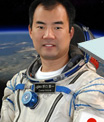ISS Expedition Operations Training
Astronaut Noguchi, assigned as an ISS Expedition 22/23 crew member, participated in training sessions on the H-II Transfer Vehicle (HTV) and on Extravehicular Activity (EVA) in preparation for his upcoming ISS expedition mission.
He received HTV-related operations training at JAXA's Tsukuba Space Center (TKSC) and NASA's Johnson Space Center (JSC). At TKSC, he simulated HTV-related operations that he will perform on orbit while the HTV "Technical Demonstration Vehicle" (maiden flight vehicle) is berthed to the ISS. He also simulated removing JAXA's external experiment, the Superconducting Submillimeter-Wave Limb Emission Sounder (SMILES), from HTV's Exposed Pallet and installing it on Kibo's Exposed Facility (EF) in cooperation with the ground team. Through this training, he further strengthened professional cooperation with the JAXA Flight Control Team (JFCT).
Along with Astronaut Noguchi, Astronaut Jeffrey Williams, assigned as an ISS Expedition 21/22 crew member, and Astronaut Shannon Walker, assigned as an ISS Expedition 24/25 crew member, participated in the simulation training. Japanese astronaut candidates Yui and Onishi attended the simulation training as observers as part of their basic training.
At JSC, Astronaut Noguchi conducted training using a simulator of the station's robotic arm, the Space Station Remote Manipulator System (SSRMS), and learned how to grab the HTV arriving at the berthing point and to install/remove it to/from the Harmony module. Astronaut Williams and Astronaut Timothy Creamer, assigned as an ISS Expedition 22/23 crew member, also participated in the training session.
In addition, Astronaut Noguchi received training in the Neutral Buoyancy Lab (NBL) at JSC on external maintenance work of the ISS, which might be needed during the expedition mission.
Astronaut Noguchi also learned how to use equipment for the experiment "Bisphosphonates", which is a Japan-U.S. joint research project designed to reduce bone loss and risk of urinary calculus formation during an ISS expedition mission.








